10 Top Things to Do in Arequipa: Visiting Peru’s White City

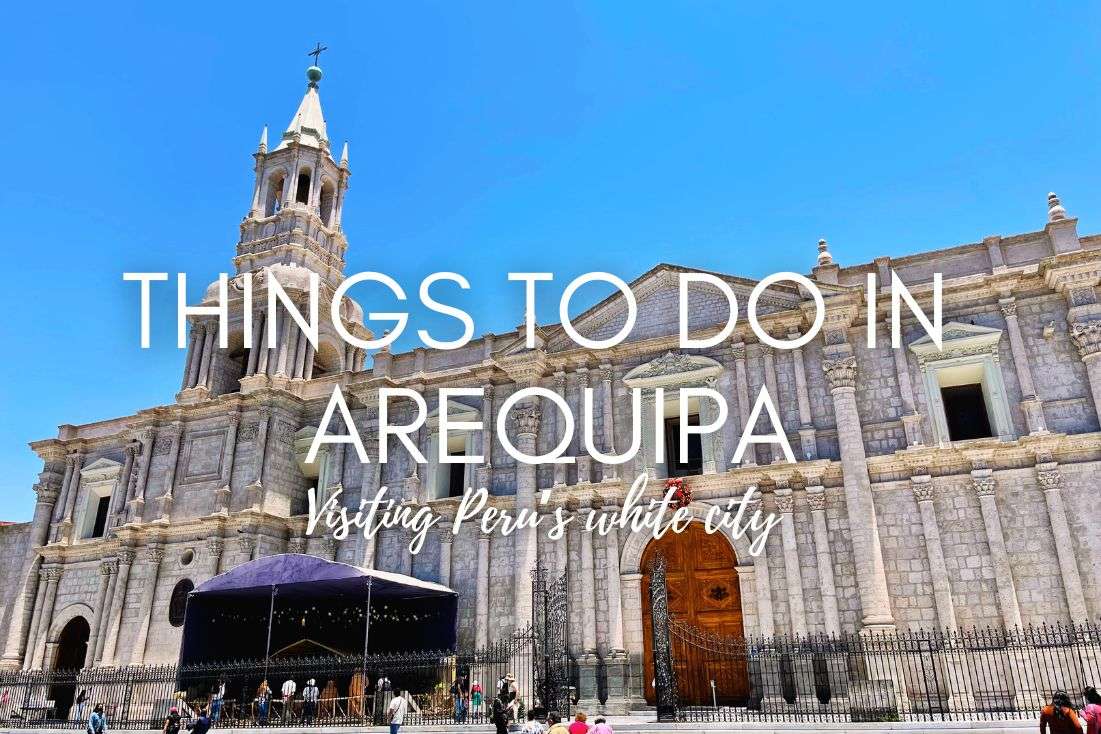
Once upon a time, the Chachani volcano threw up a light but durable stone called sillar that also happened to be white. Someone then came along and created an entire city in Peru out of it. That city was Arequipa, and it’s pretty and white.
You might’ve not heard of Arequipa, but it’s actually the second most populated city in Peru after its capital, Lima, and the seat of the country’s Constitutional Court, so it’s pretty major. That said, it is less ready for tourists than Cusco, which is not even half the size of Arequipa. Learn more about Peru.
The city sits 2,300 m (7,600 ft) above sea level. Another whopping 3,400 m (11,400 ft) above it is the summit of one of the many volcanoes, El Misti, that’s always looming in the background. The trek up the volcano is one of the tourist attractions in the area.
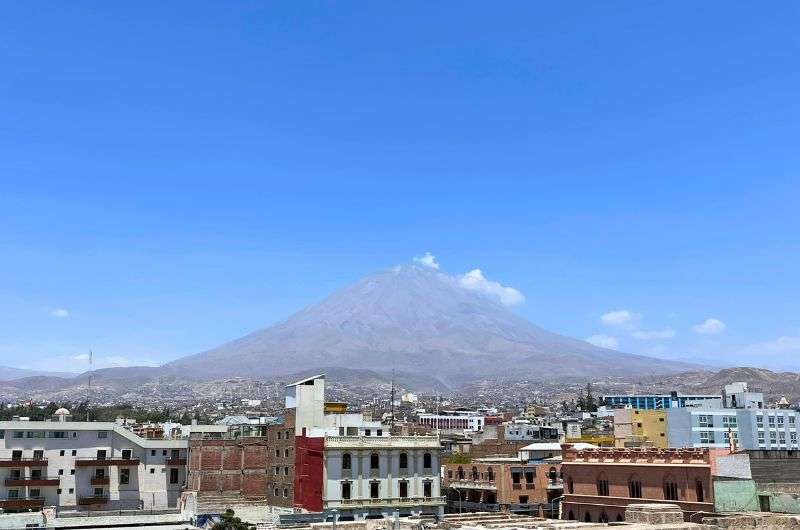
Arequipa was created by a volcanic eruption
You’ll find yourself charmed with Arequipa especially at sunset, where the white façades of the historical buildings are lit up, the pink sky highlights El Misti in the distance and locals and tourists alike crowd Plaza de Armas and enjoy a chilled beer or wine in a relaxed atmosphere.

It’s easy to spend a day wandering around Arequipa’s city center, and then adding a couple more days to explore the scenery and activities outside of the city.
Top things to do in Arequipa: An overview
Here are the best things to do in Arequipa, in order of how much I liked them:
- Laguna de Salinas—Flamingos, volcanoes, and epic lagoon reflections. Bring your camera and a spare jaw.
- Colca Canyon—One of the deepest canyons in the world, with huge condors soaring above.
- Whitewater rafting on Rio Chili—Freezing water, crazy rapids, and guaranteed fun.
- Santa Catalina Monastery—A "city within a city" that’s as colorful as it is historic.
- Arequipa historic center—Sillar buildings, cobblestone streets, and enough charm to make you fall for the White City.
- El Misti volcano hike—Spending 2 days trekking up a 5,800 m beast is no joke, but those views?
- Museo Santuario Andino—See Juanita, the frozen Inca mummy. She’s 500 years old (but just 12 years old…).
- Arequipa Basilica Cathedral and Museum—Gorgeous sillar architecture, South America’s largest organ, and rooftop views for days.
- Ruta del Sillar—Carved rock statues with just a touch of kitsch.
- Mundo Alpaca—Adorable alpacas and a gift shop that will wreck your wallet in the best way possible.
Sometimes, all you need to do is take the first step... I've filtered out the best hotels in Arequipa for you
Save it for yourself to come back to later, or share with your friends on social media!
I've already planned your ititnerary for the trip, complete with my travel tips.
Arequipa map: Where are the tourist attractions?
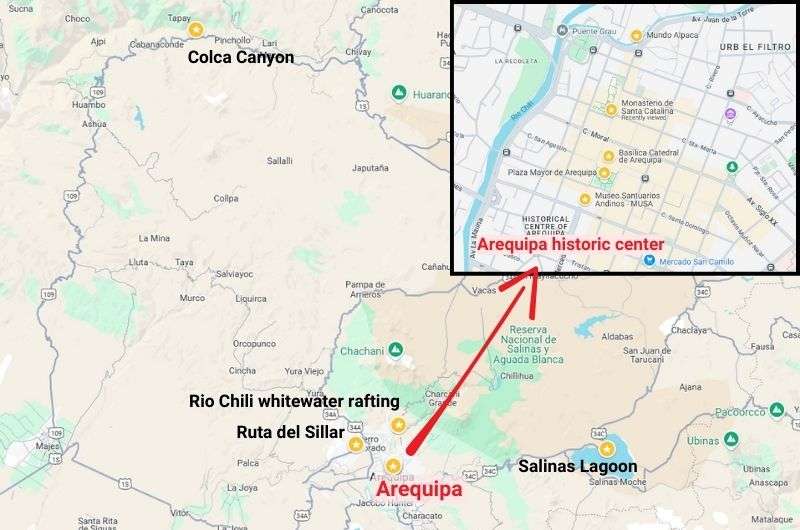
A map showing the locations of the top things to do in Arequipa, Peru
Visiting Arequipa: Know before you go
- How many days do you need in Arequipa? Plan for 2 days minimum, considering 3 days to explore the historic center, Salinas Lagoon, Colca Canyon, and doing some whitewater rafting.
- My tip: Expand your itinerary beyond Colca Canyon. Don’t visit Arequipa solely for Colca Canyon—it might not live up to the hype on its own. Add nearby Salinas Lagoon and whitewater rafting to your plans to make your trip more rewarding.
- Altitude in Arequipa: Arequipa sits at 2,300 m (7,500 ft) above sea level. It’s lower than Cusco or Lake Titicaca, so it’s a great spot to acclimate before heading to higher regions like the Sacred Valley or Colca Canyon.
- Best time to visit Arequipa: The dry season (May to October) is ideal, with sunny days and cool nights. If you want to see Salinas Lagoon when it’s full of water, visit during the wet season (December to March), though expect occasional rain and fewer crowds.
- Hotel in Arequipa: Try the centrally located, 4* Palla Boutique Hotel. Unless, that is, you hate free parking, hummingbirds, and views of El Misti from your breakfast table.
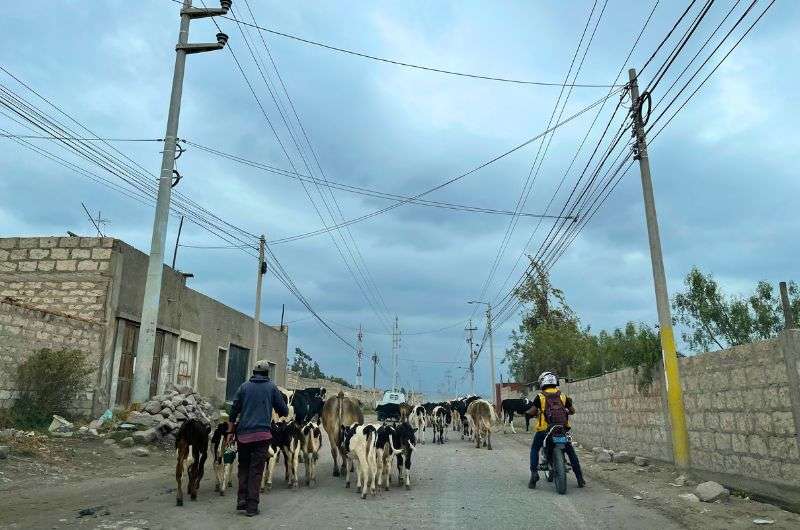
This is the traffic in Arequipa
Getting to Arequipa: Start your Peru trip the smart way
Flying into Arequipa is a solid move if you want to avoid getting smacked in the face by high altitudes right away. Instead of landing in Cusco straight from Lima and gasping for air, start in Arequipa first.
Spend a few days exploring this beautiful city (trust me, it’s worth it) and then make the scenic drive to Cusco. The gradual ascent to the Sacred Valley is much kinder to your body, giving you time to adjust before tackling the Andes.
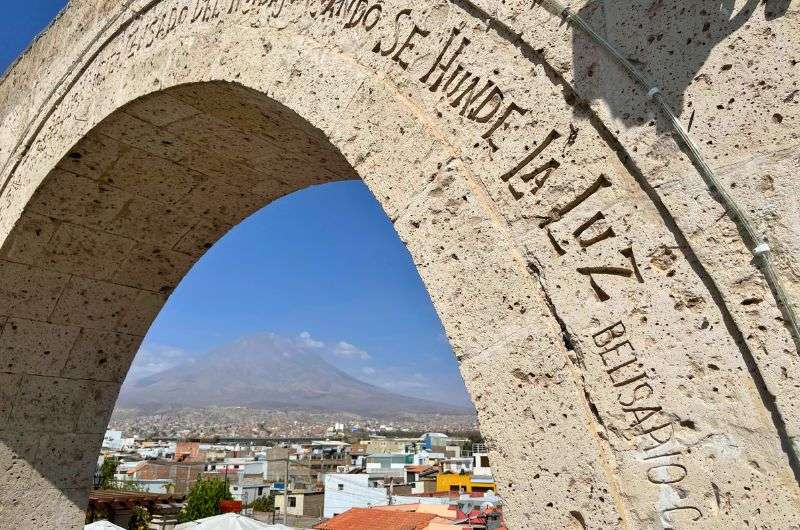
Arequipa
For the budget-conscious or the bus-loving adventurers (who are you and what did they do to you?), you can also take a bus from Arequipa to Lima. It’s a long journey but a popular one, with plenty of opportunities to see Peru’s jaw-dropping landscapes along the way. But it’s a bus, so I can’t speak from personal experience.
Either way, starting your Peru trip in Arequipa is a win. Beautiful city, lower altitude, and plenty of adventures to kick things off right.
Here’s how to enjoy your visit:
1. Experience the beauty of Laguna de Salinas in Aguada Blanca National Reserve
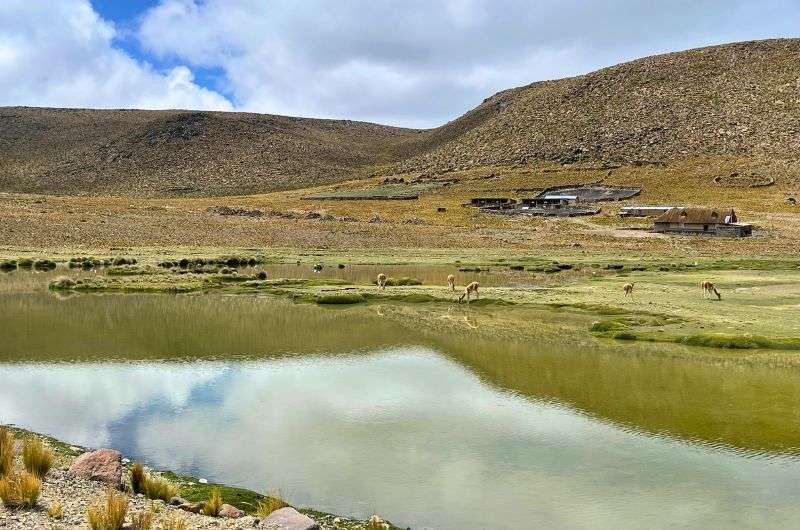
Laguna de Salinas
Laguna de Salinas is part of the stunning Aguada Blanca National Reserve, and I’m going to say it: it’s the most beautiful nature reserve I’ve ever seen! Hands down the best thing I did in Arequipa.
The mix of wetlands with tons of llamas, alpacas, and flamingos, and the snow-covered peaks of the mountains above, with multiple volcanos towering over you, makes for a landscape like no other.
Flamingos that freeze: a quirky fun fact
Fun fact: The flamingos that hang out at the lagoon during the day can freeze inside the lake on cold nights. I mean, they’re standing on one leg anyway while resting—they just have to wait until morning to be able to move again. That must suck.
When to visit Laguna de Salinas
The lagoon itself does that thing where it perfectly mirrors the nature above it on its surface—unless you visit during Peru’s dry months, from May to November. With no rain to feed the lake, the mirror evaporates and leaves behind tons of salt and no water to be seen, turning into one big salt mine. Don’t expect too much bird life when it’s dry. The flamingos and other birds enjoy the water, not the salt.
How to get to Laguna de Salinas
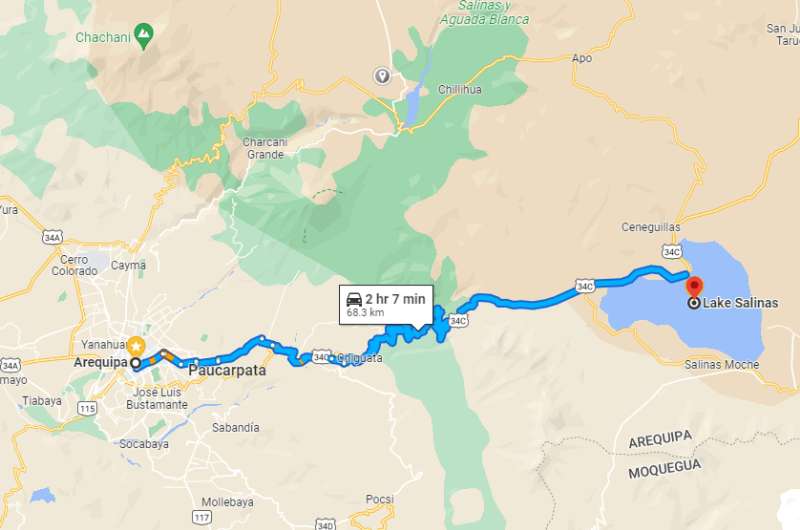
The drive from Arequipa to Lake Salinas takes about 2 hours. Notice the especially fun middle section
The drive from Arequipa to Laguna de Salinas is about 60 km (38 miles) and takes 2 hours. The road is straightforward, though in no way straight. You can bet your boots you won’t be driving on asphalt most of the time, instead dodging oncoming racing trucks on rocky dirt roads.
You’ll twist and turn, doubling your altitude from Arequipa’s 2,300 m (7,000 ft) above sea level to Laguna de Salinas’ 4,300 m (14,000 ft). It takes some effort to get there, that’s for sure. And you might have a little trouble catching your breath once you arrive—but I’m sure you’re read up on mountain sickness before traveling to Peru, right?
Should you drive or take a tour to Laguna de Salinas?
I recommend renting a car when visiting Peru and traveling independently. This is especially helpful for accessing remote places like the Aguada Blanca National Reserve. You are free to do what you like, when you like.
If you don’t want to drive yourself, you can always take an organized group tour (from USD 65), or a private one (from USD 80) in case you don’t like strangers or can’t find a group to go with.
You’ll be asked for PEN 5 (USD 1.50) at a ticket booth on arrival at the lagoon.
Pro tip: Alternatively, if you also plan on going to Colca Canyon, know that Laguna de Salinas is included in the Colca Tourist Ticket (as is Aguada Blanca and Andagua Valley of the Volcanoes).
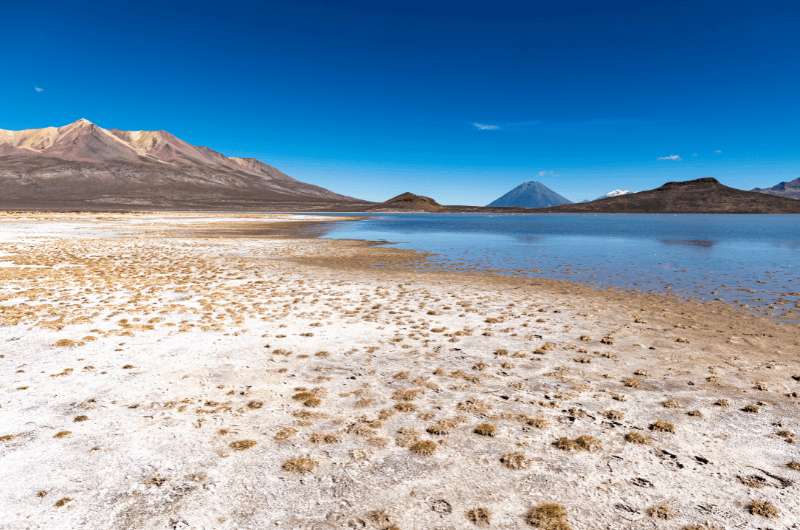
Laguna de Salinas
Make the most of your visit with flexibility
With your own car (or car and driver), you can also make as many stops as you want and drive to different vantage points, positioning yourself for that perfect shot with El Misti in the background. The Salinas Lagoon isn’t exactly tourist central, so you might even have the place to yourself.
What to do at Laguna de Salinas
Once you’re at the lagoon, take a walk among the flamingos, enjoy the peace and quiet, and soak in one of South America’s most serene landscapes. Pimp up your Instagram, and then you can be on your way. Budget one to two hours for ogling nature at Salinas Lagoon.
Just don’t forget—you still have to face the road back to Arequipa when you’re done.
2. Brace yourself for Colca Canyon
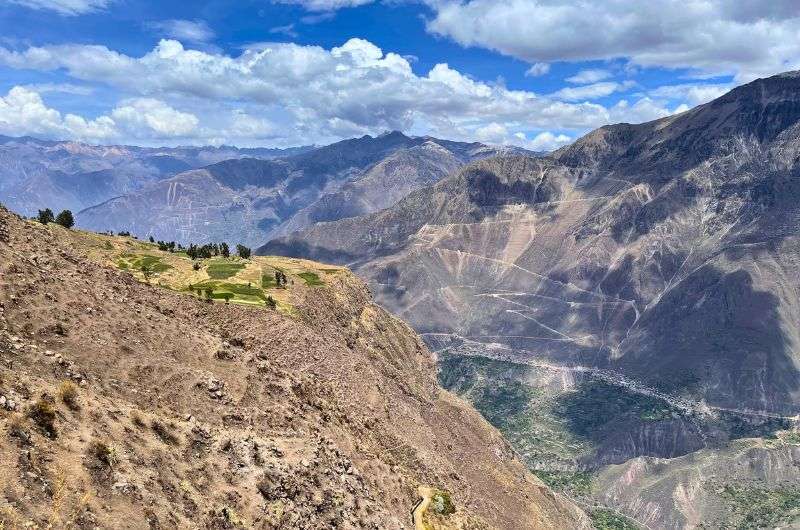
Colca Canyon’s majesty
Colca Canyon is the main reason many people visit Arequipa in the first place. But if you’re thinking it’s the only thing to do in Arequipa, maybe reconsider.
At the very least, add Laguna de Salinas, located nearby Colca Canyon, to your itinerary, or you risk a bit of disappointment. After all, the long, tiring drive to Colca Canyon will have your expectations soaring—and it’s a tall order to meet them.
Side note: I promise I’m not biased because of the food poisoning I was dealing with while taking this trip.
Exploring one of the deepest canyons in the world
Don’t get me wrong—Colca Canyon is one of the deepest canyons in the world, and it’s certainly among the deepest in Latin America. At around 3,270 meters (10,725 feet), it’s twice as deep as the Grand Canyon and stretches for 100 km, cutting dramatically into the surrounding mountains. So, not lame by any account.
And there are condors.
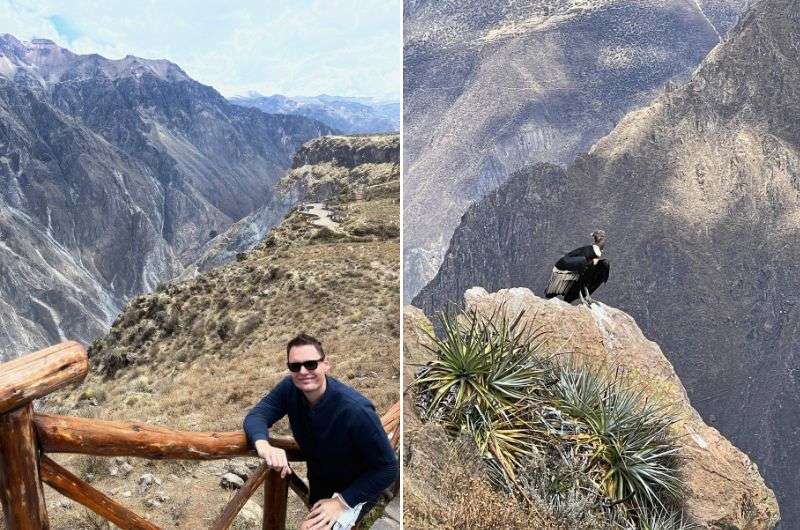
Me, smiling through the food poisoning, and my condor buddy
But even though the Grand Canyon is a baby compared to Colca, it somehow feels more like a canyon. Colca Canyon is so narrow that it just looks like… mountains. High, majestic mountains, sure, but in Peru, impressive peaks are pretty much everywhere.
Fun fact about the deepest canyons in the world: You may have heard that Colca Canyon is the second-deepest canyon in the world, but it’s not strictly accurate. The Cotahuasi Canyon, also in Peru, is actually deeper, reaching approximately 3,354 m (11,000 ft). How about we agree on Colca being the second-deepest canyon in the Americas, not the world?
Globally, Yarlung Zangbo Grand Canyon in Tibet (China) is recognized as the world’s deepest, with depths up to 6,009 m (19,715 ft)!
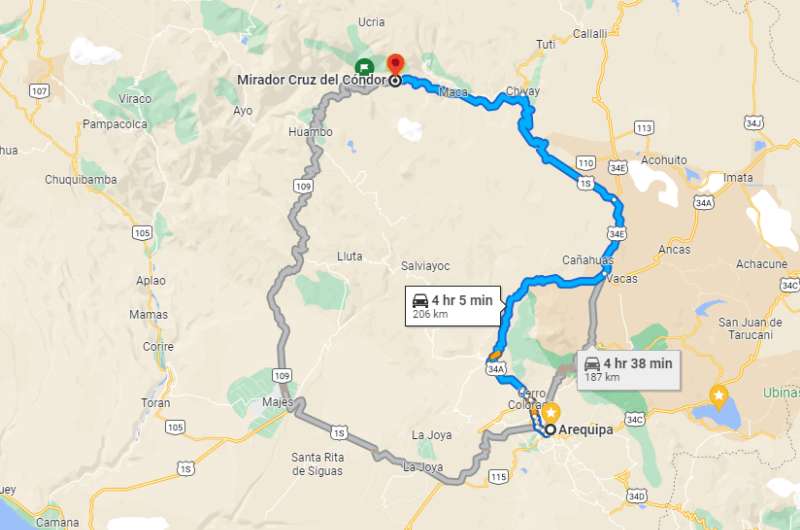
It’s a long drive to Colca Canyon!
Visiting the Cruz del Condor viewpoint
Use Google Maps as your GPS and set “Mirador Cruz del Cóndor” as your destination. There’s a parking lot on your right just before you get there. From this viewpoint, you can do a bit of walking along the paths, take photos at several wooden viewing areas, and try to spot condors. This is the best spot to see them in flight.
Explore more viewpoints in Cabanaconde
You can continue on to Cabanaconde if you want to take in more views. It’s about another 45 minutes of driving, and Mirador de Achachihua or Mirador de San Miguel are both good stops with impressive views of the canyon.
Spotting condors in the canyon
We were lucky enough to see one condor in flight and another just chilling nearby. These are big, ugly-headed birds with an impressive wingspan of about 3 m (10 ft)! Not the kind of bird you’d want sizing you up for dinner.
Should you trek or take a day trip?
I might’ve had a more amazing experience had we taken one of the many available overnight treks in Colca Canyon, but we didn’t (I’m not a overnight trekking kind of guy, honestly), instead opting for a day trip out of Arequipa.
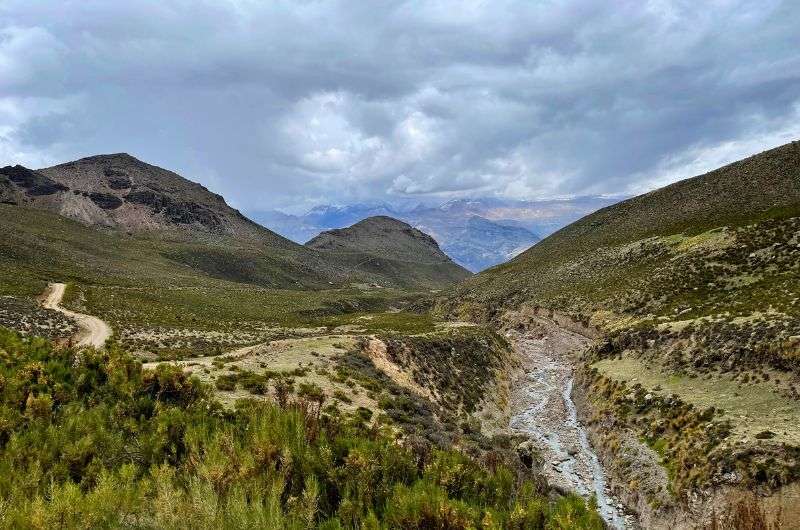
The scenery on our way to Colca Canyon
We had our own car and there was no reason other than my food poisoning (you can tell I’m still bitter about it) for Colca Canyon to not be considered the highlight of our trip to the region. But it didn’t wow us as much as it should’ve.
If you’re up for a Colca Canyon trek that requires staying the night, I’d go for it in hopes it will give you that “wow” factor we missed. Spending a night in the canyon would probably let you take in more of its dramatic depth and quiet beauty at your own pace.
And hey, with no food poisoning to dampen the experience, you might come away with a whole different story.
A 1-day tour without trekking runs about USD 50, while overnight trips start at USD 100.
How to get to Colca Canyon
From Arequipa, drive towards a town called Chivay, and then turn toward Cabanaconde to reach the lookout point, which is where many of the treks start from. It’ll be a cruel 4 hours on bumpy, winding roads, so come in high spirits and mentally prepared for it to be a long day.
Entry fees and the Colca Tourist Ticket
You’ll pay s/70 for the Colca Tourist Ticket to enter Colca Canyon. This ticket also covers entry to Salinas Lagoon and Aguada Blanca National Reserve. Bring cash and your passport—you can buy the ticket just before reaching Chivay town, and ticket-checkers will find you at all the major stops.
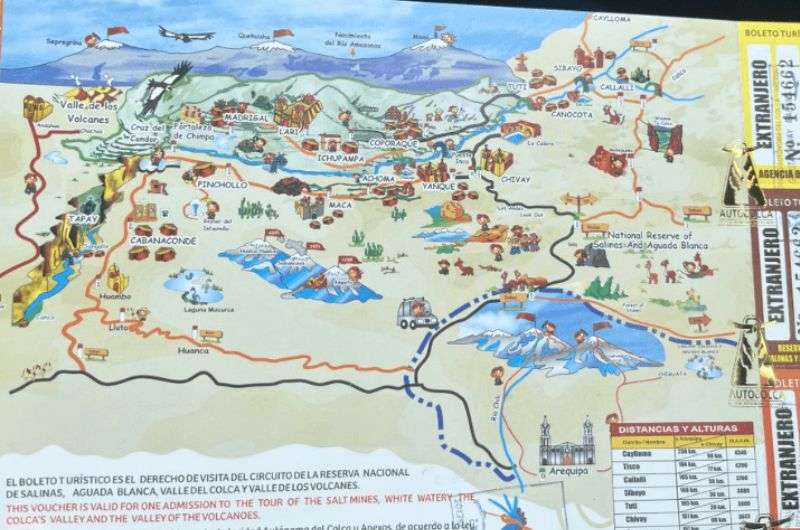
My Colca Tourist Ticket
A note on altitude sickness at Colca Canyon
Should you worry about altitude sickness? Well, the Cruz del Condor viewpoint sits at 3,700 m (12,000 ft) above sea level. It’s not extreme, but it isn’t the Netherlands either. For reference, Machu Picchu is at 2,400 m (8,000 ft), Arequipa at 2,300 m (7,500 ft), and Cusco at 3,400 m (11,000 ft).
You may feel short of breath, especially if you do any hikes, but it shouldn’t be debilitating. Just stock up on coca leaves, and you’ll be fine!
3. Go whitewater rafting on Rio Chili: A thrilling adventure in Arequipa
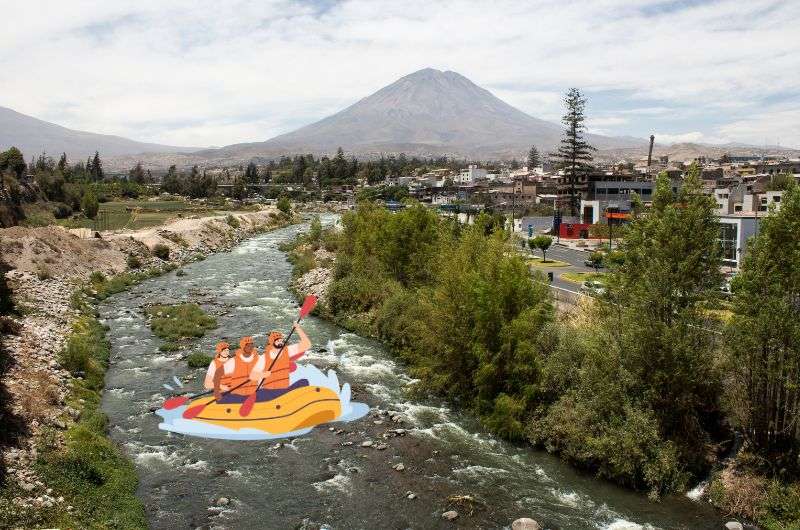
Even adventure activities can be found in Arequipa
I thought Rafting on Rio Chili was so much fun! This isn’t a mellow river ride but rather a heart-pounding journey through class 2–4 rapids. You rarely get a second to relax, as the rapids keep the excitement going.
This adventure is suitable for beginners but not for couch potatoes. You’ll work for your fun, and yes, you’ll get wet.
The crystal-clear (and freezing) waters of Chili River
The crystal-clear water of Chili River is very cold, like 8°C (46°F) cold, so it’s not something you do to splash around and giggle while you fall in.
You will be wearing a wetsuit and helmet and holding on for dear life as you hope you don’t pop out while your raft plummets down a waterfall. But in a fun way.
Where does the rafting trip start?
Your rafting adventure begins at the Chapi Charcani Sanctuary, about 20 minutes from central Arequipa. Most tours start with a minibus pickup at your hotel in Arequipa. Depending on the tour company, you’ll either get changed into your wetsuit at a gear house near the river or back in Arequipa before the drive.
After arriving at the river, your guide will give a quick tutorial on rafting basics before you embark on a roughly 1.5-hour journey down the rapids.
The rapids start off tame and gradually get wilder, giving you time to get comfortable on the raft. If you’re not feeling up to tackling the wildest part, there’s an option to get out and walk around it. But honestly, by then, you’ll probably feel like an Olympian, ready for anything.
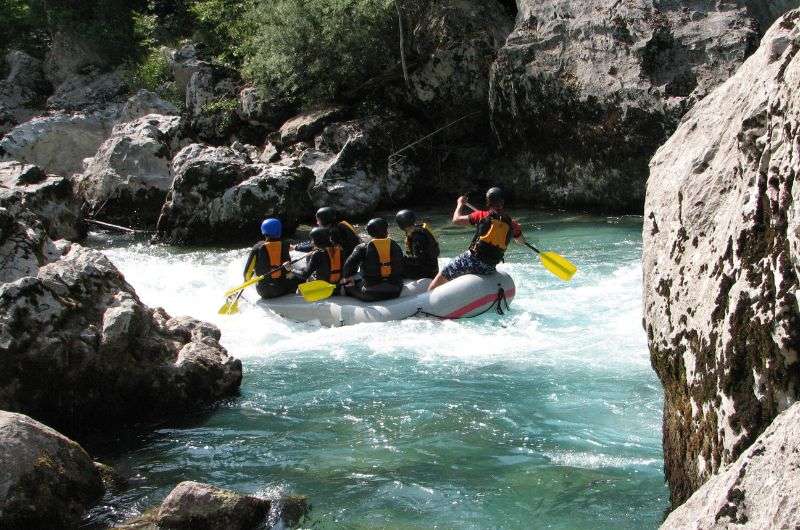
Don’t be fooled by the guide in shorts, the water was freezing
Cliff-jumping and finishing the ride
In one section, our tour stopped so people could jump into the water from the cliffs. You’ll be wet already anyway, so give it a shot!
The river takes you right back to Arequipa, so the drive to your hotel is only a very short one.
How long does it take, and how much does it cost?
The tour takes a total of 3 hours, and most companies have 2–3 departures a day. Prices from USD 25.
4. Visit Santa Catalina Monastery: A city within a city in the White City
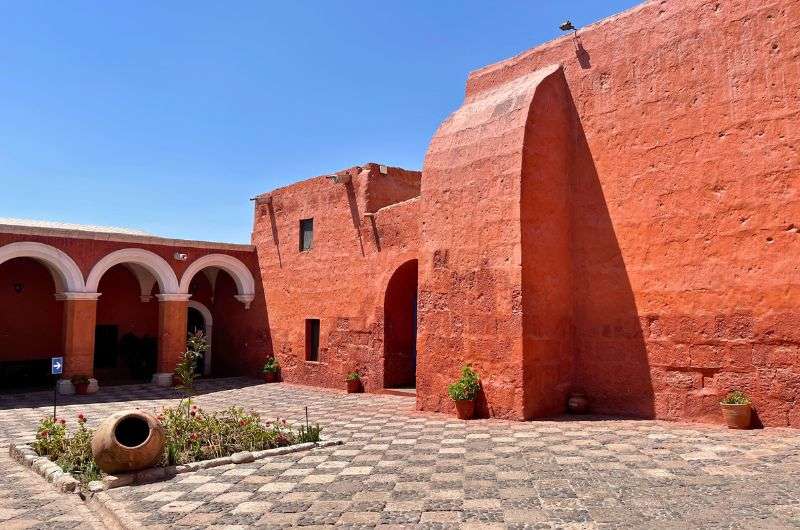
Santa Catalina Monastery—little bit of red in the white city
The Santa Catalina Monastery (Monasterio de Santa Catalina) is a city within a city, with streets, squares and passages, it even has four distinct neighborhoods!
Just like everything else in the entire city of Arequipa, the monastery buildings are made of the white volcanic stone called sillar. Unlike everything else though, the monastery is colorfully painted! Some areas are all red, some all blue, and so on. Very nice!
Life of luxury for high-society nuns
You might think of nuns as humble women with no worldly possessions and needing nothing but love and basic food to happily live until they are called to the heavens by God himself.
Well, the Santa Catalina Monastery was like the Monaco of monasteries! Founded in 1579 by Doña María de Guzmán, a beautiful rich widow of a previously rich but now dead Spaniard, she really set the tone for the next 300 years.
The monastery was pimped out! They only accepted upper-class Spanish ladies who had to pay a hefty dowry to get in (an equivalent of today’s USD 150,000!), as well as bring along a nice list of things with them, like paintings, lamps, and statues.

Santa Catalina Monastery
The nuns also had slaves and servants, so basically living their extra life in style and comfort, just without men. There were 450 of them there.
The Pope’s reform of Santa Catalina
It wasn’t until the 19th century when the Pope himself decided that this monastery needed a serious reform. The riches were sent away and the slaves were freed, getting the option to either stay and be a real nun or leave.
I’d imagine that getting down to real nun business probably wasn’t accepted very well by the fancy nuns living there.
Practical tips for visiting Santa Catalina Monastery
It is easy to see the monastery on your own since there are plenty of informative signs. There are guides available too.
You will easily spend 2 hours exploring. We spent longer due to my obsession with reading each sign to the very last letter and seeing every nook and cranny. Beautiful Plaza de Armas is nearby, so you could plan a visit there as well when you visit Arequipa.
- Open daily: 9 am–6 pm (until 8 pm on Tuesday–Thursday)
- Tickets: PEN 45 (USD 12)
5. Walk around Arequipa city center: Exploring the heart of the White City
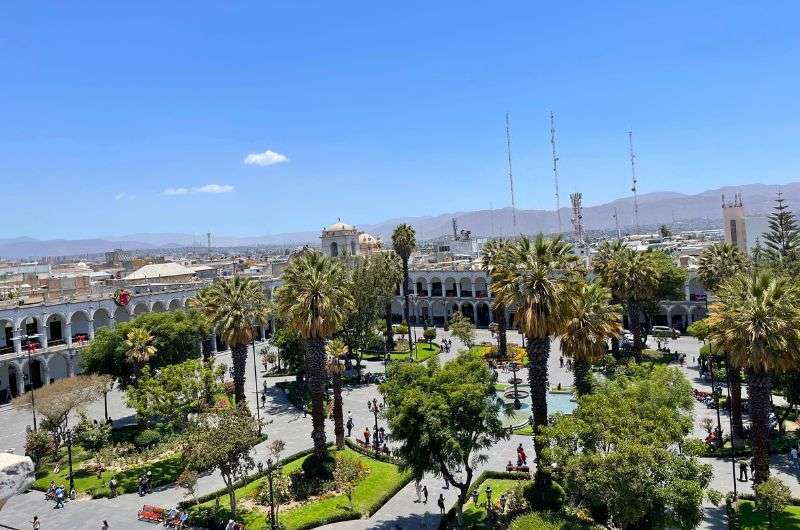
Time for a walk around the city center of Arequipa. This is Plaza de Armas!
You’ll be struck by the whiteness and cleanliness (possibly a side effect of the whiteness) of Arequipa from the moment you get there. It’s just beautiful.
Add a huge, symmetrical volcano in the background, and you’ve got yourself a winner that you need to add to your Peru bucket list.
Plaza de Armas: The centerpiece of Arequipa
The Plaza de Armas in Arequipa is the nicest I’ve seen in all of South America. For clarification—the main squares in most cities in Peru are named Plaza de Armas.
The main square in Arequipa is big, full of palm trees and manicured bushes in the center, lined by the impressive Arequipa Basilica Cathedral and tons of shops and cafes on all sides. Those, too, are hidden behind the arch-covered walkways. All white, naturally.
Historical context: A UNESCO World Heritage Site
The historic center of Arequipa was declared a UNESCO World Heritage Site in 2000 due to its stunning colonial architecture made from sillar, the volcanic stone that defines the city’s unique look.
During the colonial period, Arequipa became a critical trade hub between the coast and the Andes, which is reflected in the grandeur of its buildings and urban planning.
A glimpse of religious art at La Iglesia de la Compañía
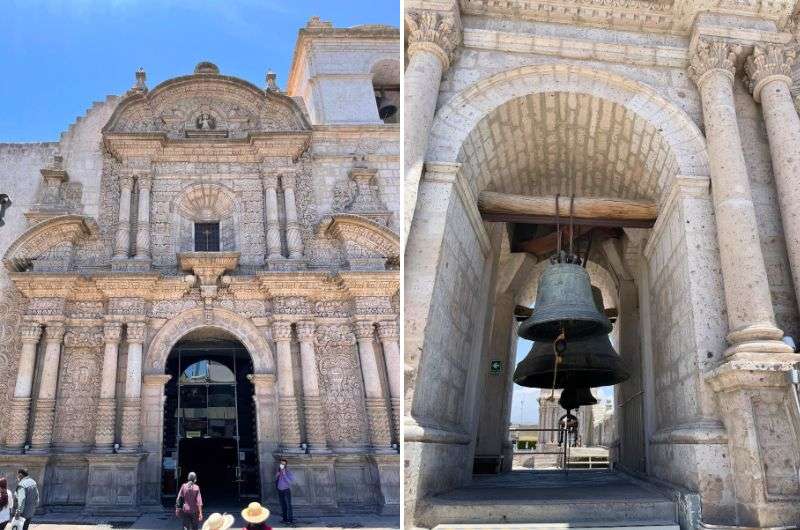
La Iglesia de la Compañía
La Iglesia de la Compañía, a church with an incredible, intricately carved entrance, is located just off the Plaza de Armas in the southern corner. It seemed more ready for worshippers than tourists when we were there, but no harm in just taking a peek, if only at the exterior. I wouldn’t barge in during mass.
Cultural highlights in the city center
The Plaza de Armas is the life of the party during cultural events and festivals. It’s especially lively in August for Arequipa’s anniversary celebrations.
Picture traditional dancers twirling and Andean music echoing through the square. Add enough street food to make you rethink that second helping of rocoto relleno (a spicy Peruvian stuffed pepper).
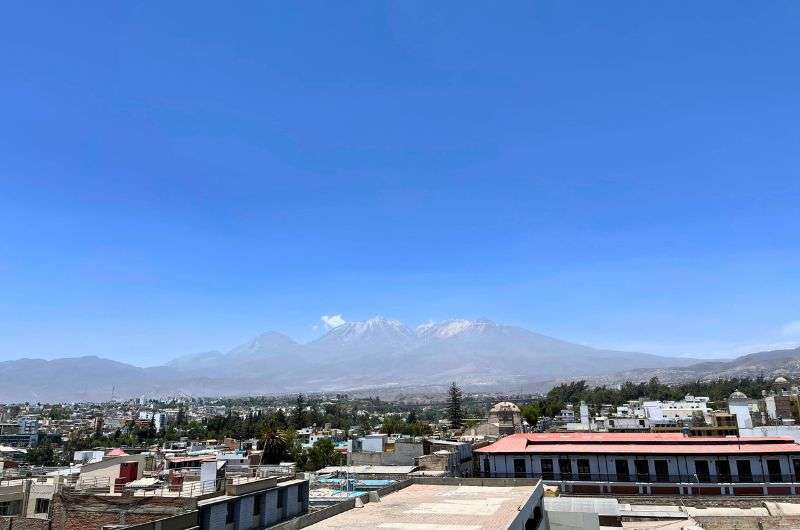
The White City of Peru with fantastic blue skies above
The square is a favorite hangout for both locals and tourists. You can soak in the vibes and maybe even join the fun if you’re feeling brave—or just really full. For a quieter experience, grab a coffee or try traditional Peruvian dishes at one of the cafes or restaurants tucked under the arch-covered walkways.
Pro tip: If you're looking for a high-quality café near Arequipa's Plaza de Armas, Chaqchao Chocolates is an excellent choice. Another notable option is Palacios Coffee, which is celebrated for its dedication to coffee craftsmanship. I have to say I was disappointed with the coffee in Peru overall, but this spot wasn’t bad.
6. Take on the El Misti hike: Climbing the iconic volcano above Arequipa
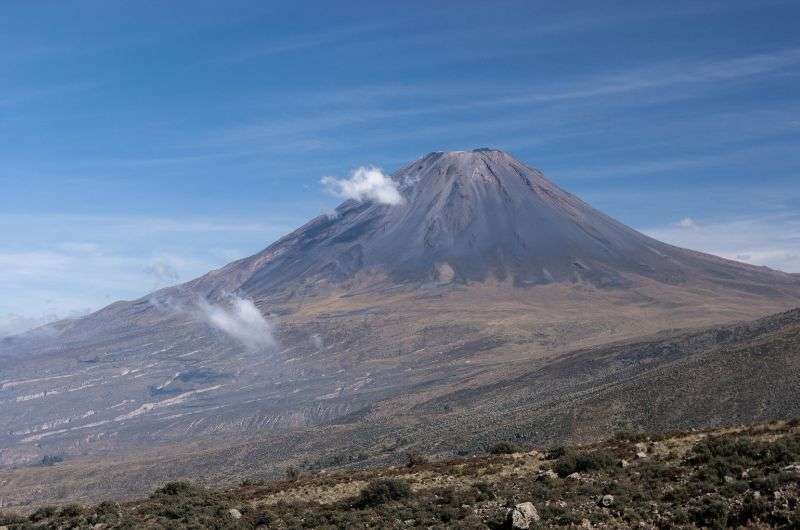
El Misti volcano
Like a Big Brother always watching, the active El Misti Volcano calmly towers over the fantastic city of Arequipa. No matter where you are in the city, you’ll be able to see El Misti standing there, all stately and mighty.
What to expect from the El Misti hike
With an altitude of 5,800 m (19,000 ft), a hike up to the summit is not for beginners. If it weren’t for the cold and altitude, it would actually be relatively easy.
Novice hikers do attempt to conquer El Misti, as it’s one of the most accessible high summits in the world, but about half of most tour groups turn back without reaching the cross at the top due to exhaustion and altitude sickness. This is not an easy hike.
Get acclimated for a few days to avoid altitude sickness
Stock up and chew coca leaves to help with the altitude at El Misti. We like them in the chocolate-covered variety.
Definitely only try this trek if you’ve had time to acclimatize for a few days beforehand. Spend a couple of nights at Colca Canyon or hang out in Cusco and the Sacred Valley before doing the El Misti hike. Altitude sickness is real, and it can ruin the whole experience.

Preparing for a two-day trek
Most often, El Misti is trekked over two days, with one night spent at base camp.
On the first day, you’ll carry a heavy backpack with all the overnight supplies and at least 5 liters of water.
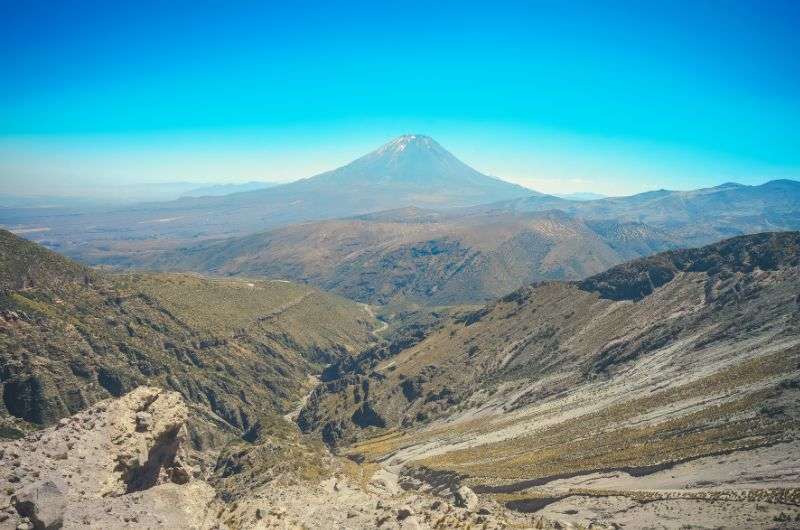
Set aside 2 days for this hike
On the second day, you go with a smaller, lighter pack, but by then, the high altitude will make you feel like you’re carrying 20 kg anyway.
Trekking the trail to El Misti summit
The El Misti hike is usually done over two days. The trailhead is about a one-hour drive out of Arequipa.
On the first day, you’ll hike uphill for about 6 hours (yes, with a heavy pack) until you reach base camp at 4,600 m (15,000 ft). Go to bed early, as you’ll be woken up around 1 am to set out for the summit in darkness.
The final ascent on the second day takes 5–7 hours to reach El Misti’s summit.
The way down is much faster—you’ll essentially slide down in the sand the whole way. It generally takes 2 hours down to base camp and 2 more hours to return to the starting point.
The hiking experience: sand, scree, and some serious wind
Expect to be walking on loose gravel and small rocks, known as scree, which can shift underfoot. When there’s wind, gusts will blow sand and volcanic ash into your face as well. Snow is typically minimal or nonexistent, so it usually won’t pose any major challenges if present.
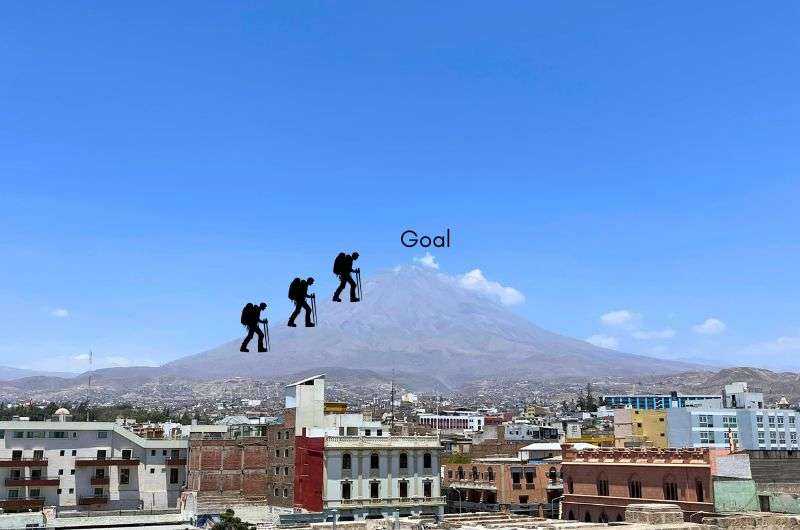
There’s your goal!
Tips on gear and weather for the El Misti hike
No special climbing gear is needed; you can simply trek all the way to the top. Just make sure you have proper clothing, as it’s literally freezing up there. Obviously, proper hiking boots are necessary. Trekking poles are optional but can be a huge help.
If you’re going in the colder months (May through October), crampons and ice picks may be necessary and can be rented in Arequipa.
Clothing can also be rented, but I advise you to go with an agency only after reading reviews properly. Some don’t have proper clothes for rent, and people end up hiking in sneakers, dealing with frostbite. Trust me, you won’t reach the summit in sneakers.
No matter which tour company you you go with, always bring your own snacks—exhaustion is real, and even the good companies won’t supply energy bars. And remember, 5 liters of water is the absolute minimum you need to bring.
Choosing a reputable tour operator
Like I mentioned before, really read recent reviews online before choosing your tour operator. There are shady operators with inexperienced guides who make promises they can’t keep.
Ask questions about the clothing and shoes you’ll need or will be renting, the overnight gear that’s provided, and the food you’ll be given. There are too many stories of hungry hikers who were given only one barely edible meal for the entire trip.
7. Check out Museo Santuario Andino: Exploring the frozen mummies of southern Peru
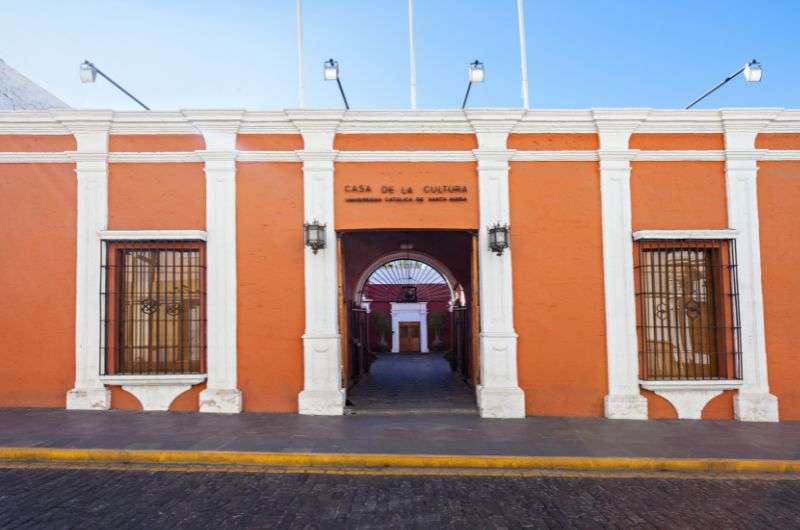
Museo Santuario Andino
Meet Juanita: The frozen sacrificed child
Not for the faint of heart, this museum dives deep into the ancient practice of Inca sacrifices, which were integral to their worship rituals. You’ll learn plenty about these chilling ceremonies as you explore the museum. At Museo Santuario Andino, you can see Juanita, the "Ice Maiden," a frozen sacrificed child preserved in stunning detail.
The Incas and their mountain gods
The Incas worshipped the mountains as gods, and to keep those gods happy, they’d offer them children in a ritual that might seem shocking to us today.
Instead of taking children from lower classes, which I somehow presumed would be the case, they took high-class citizens’ kids, drugged them, and performed ritualistic sacrifices. While the burial was a form of live sacrifice, the Incas went to great lengths to reduce suffering. For its time, this was actually considered more humane compared to some other societies’ practices. The boys, however, had a different fate.
How did they choose the child? The Incas believed that the most "perfect" and pure sacrifices would please the gods more effectively, so they chose children who were considered physically and socially “ideal.” The sacrifice was a high honor for the family, as the children were thought to join the gods and become protectors of the community.
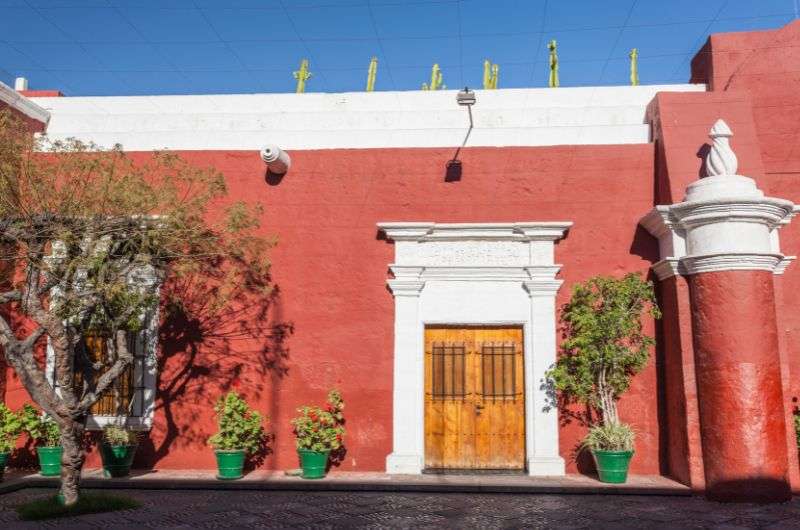
Explore Museo Santuario Andino
How Inca sacrifices varied by gender
If the child was male, he would often be left on the mountain with a metal pole, leading him to be struck by lightning. This brutal ritual didn’t do much for preserving the body, so only fragments of male sacrifices have been found.
Girls, on the other hand, were buried holding ceramics, sparing them from lightning strikes. They instead froze in the high-altitude mountain conditions with their skin and even internal organs intact, allowing modern scientists to learn incredible details about Inca society and sacrificial practices.
Museo Santuario Andino: One of the most morbid museums
The Museo Santuario Andino in central Arequipa is one of the most morbid museums I’ve ever been to, second only to the Museum of Egypt in Turin, Italy. Go if you’re fascinated by mummies and don’t mind the unsettling atmosphere—though note that Juanita is not always on display.
Museum location, hours, and entrance fees
The museum is right next to Plaza de Armas in central Arequipa.
- Opening hours: Open Tuesday to Saturday 9 am–6 pm, Sunday 9 am–2 pm, closed on Mondays
- Tickets: PEN 20 (USD 5.30)
8. Take photos of the Basilica Cathedral of Arequipa: A gem of the historic center
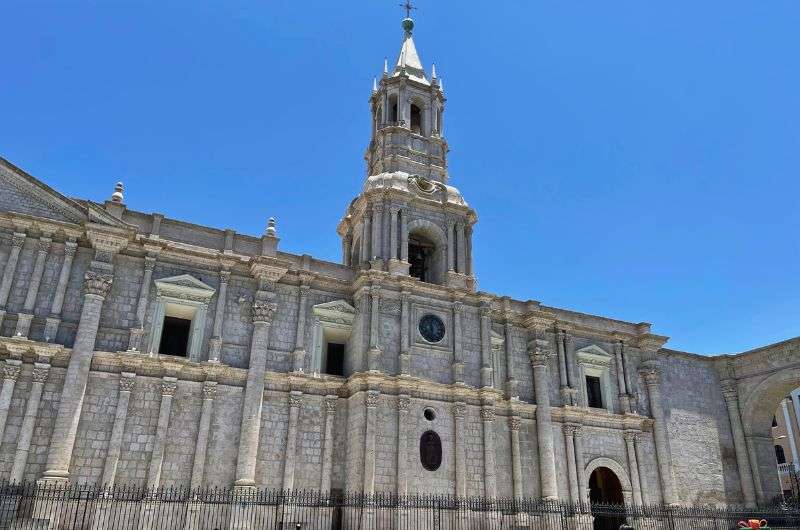
Arequipa Basilica Cathedral
An architectural wonder made of sillar
This massive cathedral is impressive from the outside, so really take it all in (especially from the rooftop!). Like almost everything in the historic center of Arequipa, the cathedral is made of sillar, giving it a bright white color.
The inside isn’t particularly amazing, though it does have some interesting bits and bobs to check out.
What’s included in the visit?
You are only allowed to visit with a guide, and the tour includes the inside area, the museum, and the rooftop views.
Our guide was amazing and made the visit totally worthwhile. He told us about the cathedral’s organ, which is the largest organ in South America—and only three people know how to play it!
Unique religious art and Andean sanctuaries artifacts
The museum is interesting, showcasing religious artifacts, wooden sculptures, and liturgical objects made of or enhanced with metal and precious stones.
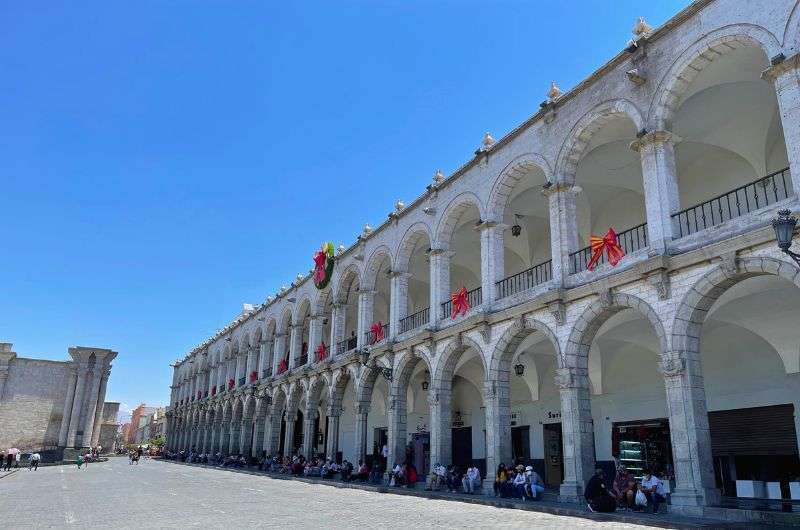
Exploring the architecture of Arequipa
Another unique feature of the cathedral is the big devil depicted on the bottom of the wooden pulpit. Seeing the devil get such a prominent role in a church isn’t something you see every day! Of course, he’s being crushed under the feet of the pastor, so it’s not exactly a celebration of the devil.
The rooftop: Views of the entire city and El Misti
Finally, you walk up the stairs to the bell tower and get fantastic views not only of the entire city of Arequipa, but also of El Misti in the background. The rooftop is a highlight of the tour and a fantastic spot for photos.
Tips for your visit
- You can take photos in the cathedral and on the roof but not in the museum.
- Make sure to dress appropriately—no knees or shoulders visible—or you might end up being frowned upon and crushed like the poor devil.
- Guides are freelancers, so if you get a good one, make sure to reward them with an extra nice tip!
Practical information for the Basilica Cathedral of Arequipa
- Opening times: Monday to Saturday 10 am–4:15 pm (closed Sundays)
- Tickets: Cost PEN 10 (USD 2.60) and include a mandatory guide (enter for free during mass)
9. Discover Ruta del Sillar: A volcanic stone quarry
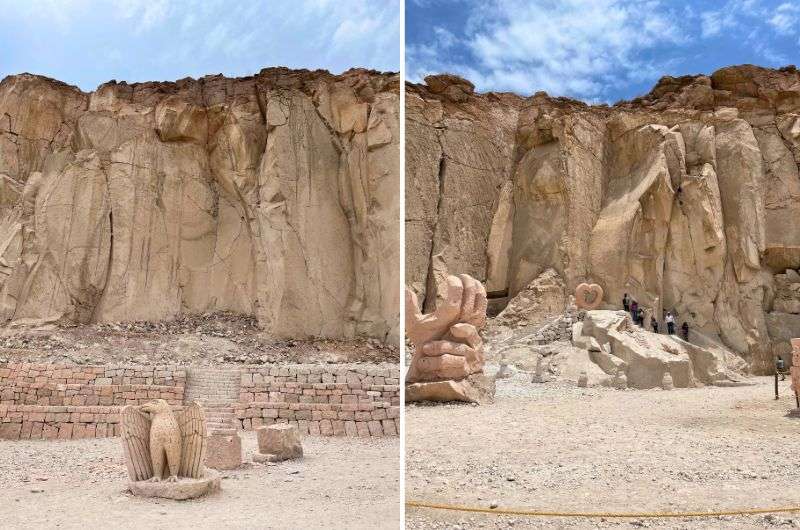
Ruta del Sillar
Ruta del Sillar is a quarry with a unique display of statues carved from volcanic stone known as sillar. Are you excited yet? They’re actually pretty nice, and it’s a cheap and easy stop in Arequipa, so why not. Not the most exciting thing to do in Arequipa, but a nice little side trip nonetheless.
Getting to Ruta del Sillar
From central Arequipa, Ruta del Sillar is an easy 30-minute drive. Located northwest of town, it has parking spots right where Google Maps takes you. Just plug in “Ruta del Sillar” and you’re good to go!
Sillar: The volcanic rock of Arequipa
Sillar is a type of volcanic rock that, in the Arequipa region, contains andesite crystals, giving it a striking white color. This stone has been used extensively in Arequipa, giving the city its nickname, “The White City.” The statues at the quarry, also made from sillar, range from beautifully crafted to kitsch, but they’re all part of the fun.
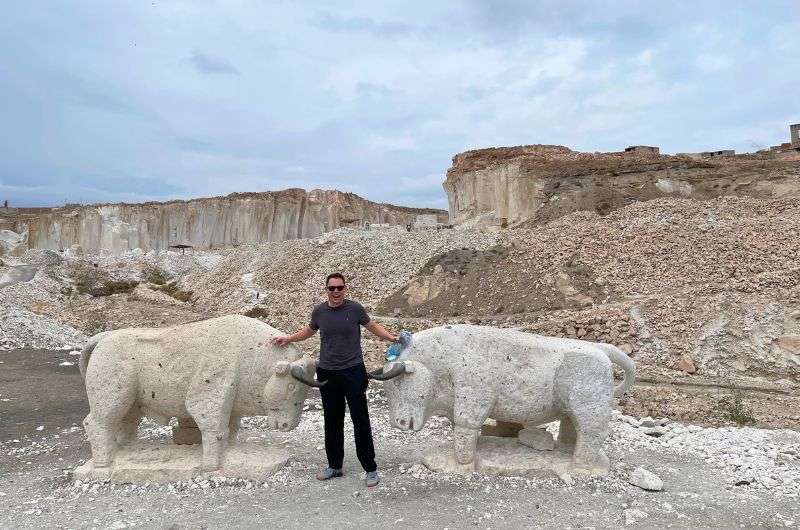
Me, fighting bulla on Ruta del Sillar
What you’ll see at Ruta del Sillar
The area with the statues is quite small and has a wide path leading you through it. You’ll see columns carved directly into the rock towering above you, along with sculptures ranging from fighting bulls to child-pleasing cars—everything as white as chalk. Some of the statues are better than others, so just take it as it is.
To get to the heart of the quarry, you’ll need to climb a few stairs, and there’s even a ferrata-esque setup if you want a selfie with the flag of Arequipa. For close-ups of some of the sculptures, you’ll pay a small extra fee on top of the PEN 5 (USD 1.50) ticket price.
Practical tips for visiting Ruta del Sillar
The toilets are shaped like little igloos and, naturally, are made of sillar. They are free to use and located at the exit.
All in all, you only need about 20 minutes at this tourist attraction unless you’re there with a guide who can tell you more about the life of the workers at the quarry.
10. Learn at Mundo Alpaca: Meet Peru’s fluffiest ambassadors
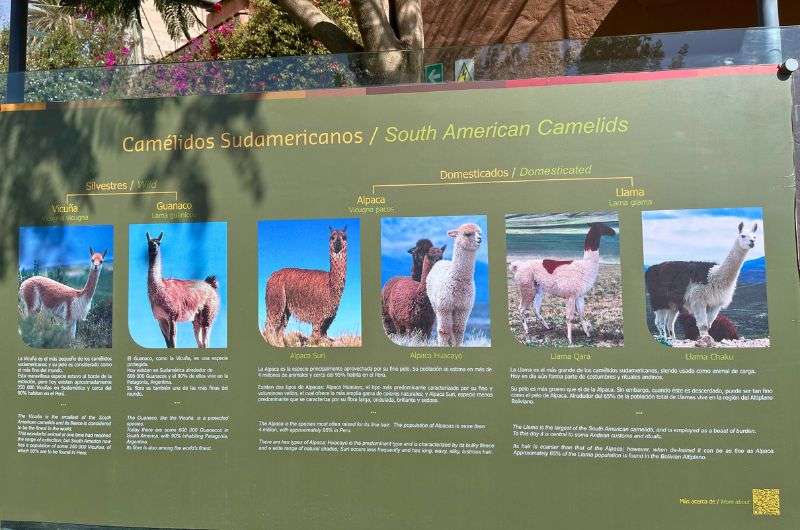
Mundo Alpaca: I still can’t seem to get them right
The Mundo Alpaca is a museum where you can meet llamas and alpacas and learn the differences between them. Because I know I couldn’t tell one from the other before this visit! Trying to spot the ones with the furrier faces and calling them alpacas doesn’t always work that well.
Immersing yourself in the textile industry
At Mundo Alpaca, you’ll truly immerse yourself in the textile industry tied to these animals. You’ll see loads of colorful fabrics and clothing articles on display.
To really appreciate the complexity and craftsmanship that goes into creating the clothing, there’s a display and presentation about each step of the process. Just look at that pile of wool!
Did you know alpaca wool is 5x warmer and stronger than sheep’s wool? It’s also incredibly soft and comes in over 20 natural shades.
Exit through the gift shop—prepare to shop!
Once you’re convinced that alpaca wool is the best thing since sliced bread, you conveniently exit through the gift shop. I loaded up on sweaters and coats that I’m sure will last a lifetime. Plus, the price was fantastic compared to what items of this quality would cost in Europe.
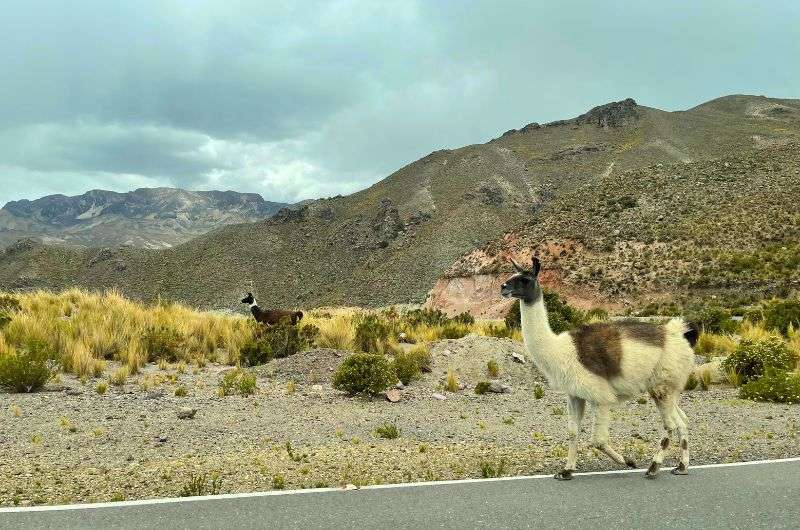
In Arequipa you can meet alpacas even outside the Mundo Alpaca... or are these guanacos...
Some advice: skip the touristy gear
Just to vent a personal annoyance—tourists that buy the typically touristy hats and ponchos in crazy colors end up looking silly. Most of the time, these aren’t even things Peruvians themselves wear. Do yourself a favor and buy something sensible. It’ll still get the job done and you can wear it at home, too, without looking like a total dork.
Alpaca care and final thoughts
You’ll be happy to know that alpacas at Alpaca Mundo are very well cared for and have, for the most part, loving owners. So, wear that sweater with a light heart!
Practical information: Mundo Alpaca visit
- Open Monday to Sunday: 8:30 am–6:30 pm
- Free entrance (but you’ll leave cash at the store, I promise!)
Is Arequipa worth visiting?
Absolutely, Arequipa is a fantastic destination! Salinas Lagoon and whitewater rafting on Rio Chili were my favorite day trips from the city. While I rarely spend more than a day in any city, Arequipa’s surroundings are so rich in experiences that it’s worth staying at least two nights to make the most of your visit.
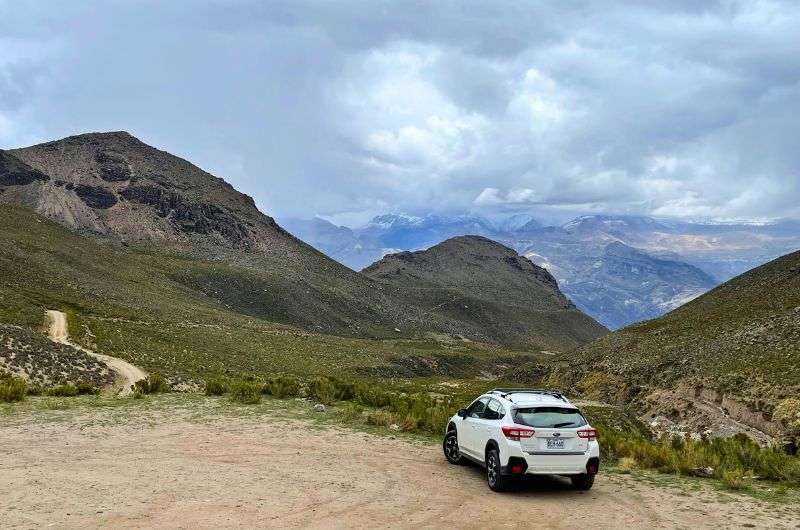
Arequipa’s sooo worth it!
Is Arequipa better than Cusco?
No, I can’t imagine anyone skipping Cusco, but it depends on what you’re looking for. Arequipa is quieter and less crowded than Cusco, with stunning colonial architecture made from sillar and incredible day trips like Colca Canyon and Salinas Lagoon. Cusco, on the other hand, is your gateway to Machu Picchu and the Sacred Valley, with a vibrant energy all its own. Ideally, visit both—they complement each other beautifully.
Is 2 days in Arequipa enough?
Two days is the sweet spot for Arequipa if you’re planning to explore its surroundings. Spend one day in the historic center and another on a day trip like Salinas Lagoon or Colca Canyon. If you want to tackle El Misti or whitewater rafting, add an extra day to your itinerary.
When’s the best time to visit Arequipa?
The best time to visit Arequipa depends on your priorities. For dry, sunny weather ideal for exploring the city and hiking, visit during the dry season (May to October). However, if you’re also planning to see Salinas Lagoon when it’s full of water, aim for the wet season (December to March). Rain comes in hard and fast, mainly in the afternoons, but it’s still a great time to go.
Sometimes, all you need to do is take the first step... I've filtered out the best hotels in Arequipa for you
Save it for yourself to come back to later, or share with your friends on social media!
I've already planned your ititnerary for the trip, complete with my travel tips.
You might also be interested in reading:
- The Best 3-Day Cusco Itinerary with Sacred Valley Day Trip
- A 2-Week Peru Itinerary: A Day-By-Day Trip Plan
- Top 14 Handpicked Luxury Hotels in Peru (With Prices)
- The 10 Best Ruins to Visit in Peru
- Top 9 Places to See in Sacred Valley
This post contains affiliate links. I earn a small commission if you make bookings through my links, at no additional cost to you. Thank you for your support!




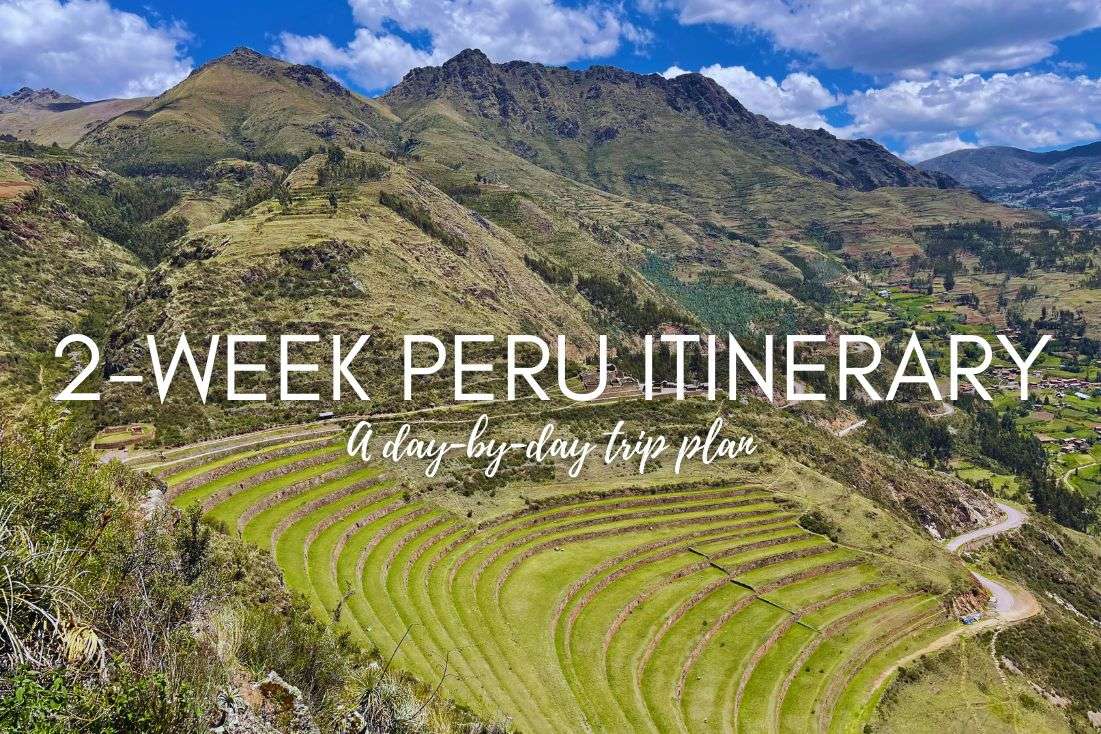
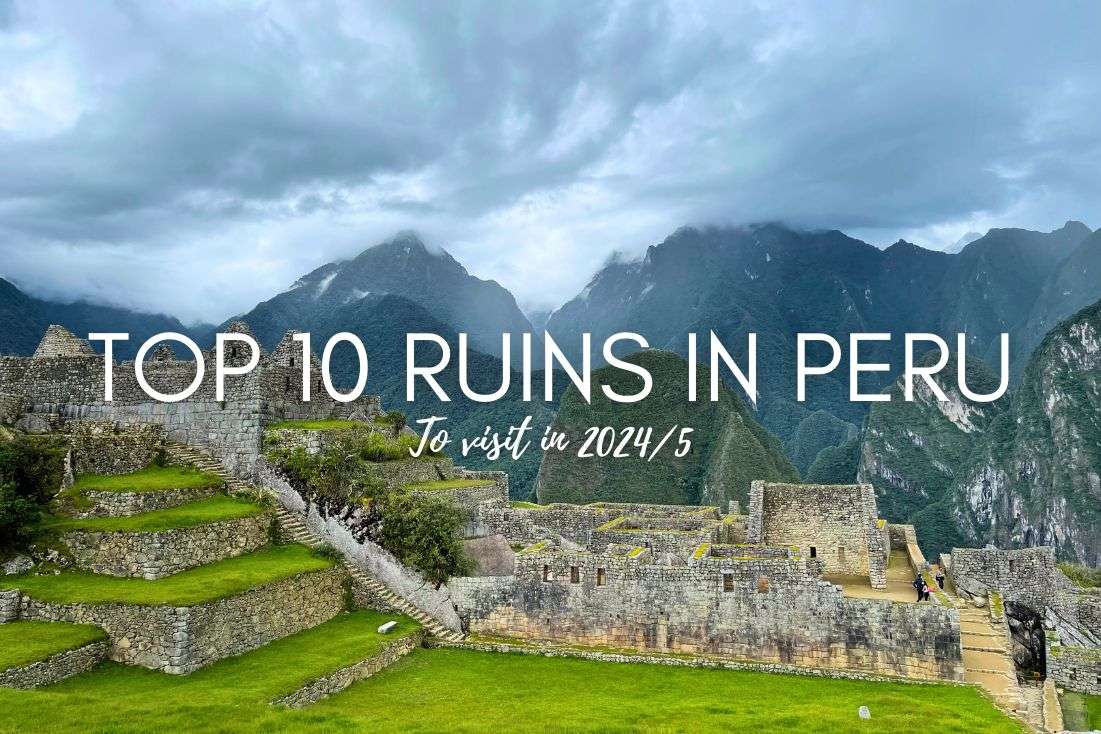
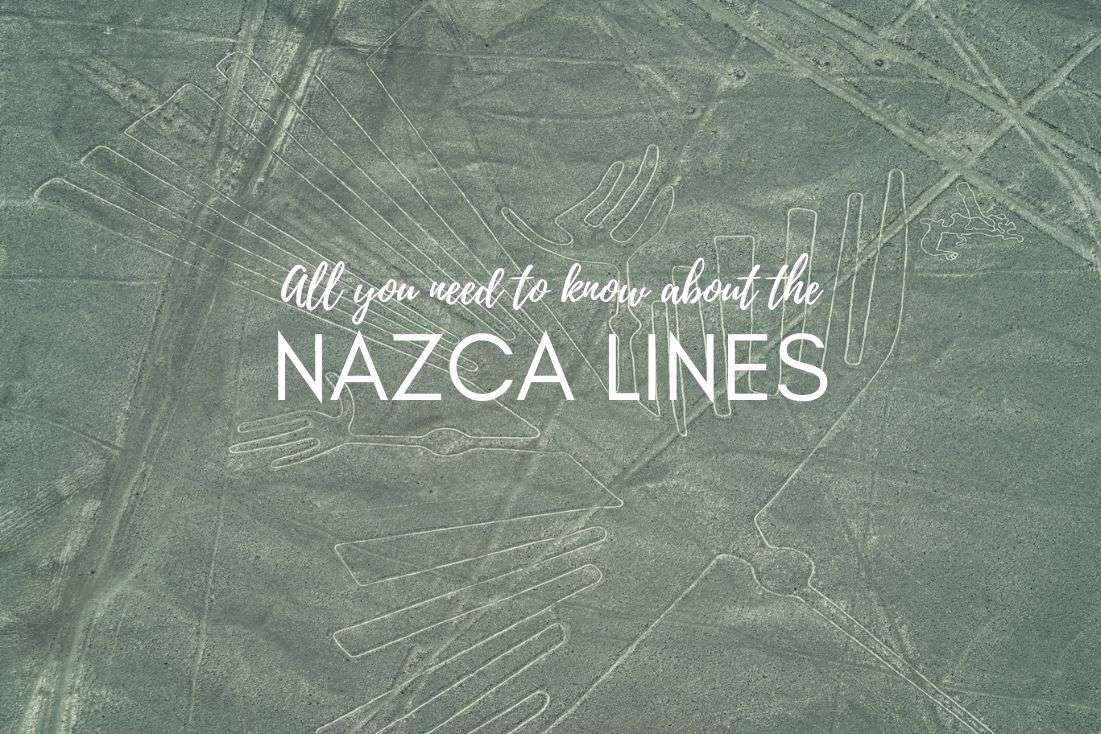



Comments | Thoughts? Give us a shout!